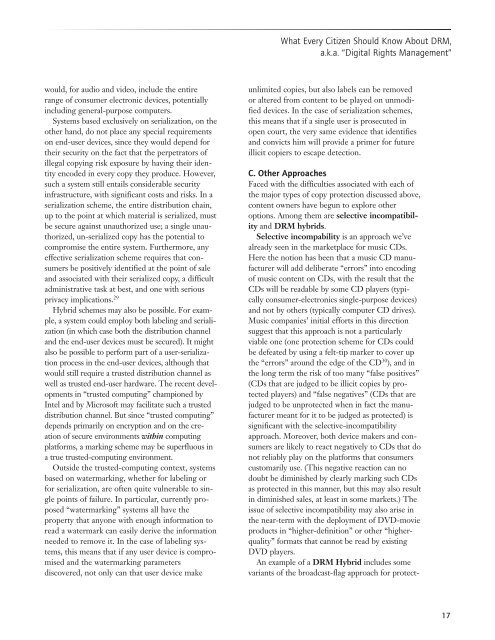What Every Citizen Should Know About DRM, aka - Public Knowledge
What Every Citizen Should Know About DRM, aka - Public Knowledge
What Every Citizen Should Know About DRM, aka - Public Knowledge
Create successful ePaper yourself
Turn your PDF publications into a flip-book with our unique Google optimized e-Paper software.
<strong>What</strong> <strong>Every</strong> <strong>Citizen</strong> <strong>Should</strong> <strong>Know</strong> <strong>About</strong> <strong>DRM</strong>,a.k.a. “Digital Rights Management”would, for audio and video, include the entirerange of consumer electronic devices, potentiallyincluding general-purpose computers.Systems based exclusively on serialization, on theother hand, do not place any special requirementson end-user devices, since they would depend fortheir security on the fact that the perpetrators ofillegal copying risk exposure by having their identityencoded in every copy they produce. However,such a system still entails considerable securityinfrastructure, with significant costs and risks. In aserialization scheme, the entire distribution chain,up to the point at which material is serialized, mustbe secure against unauthorized use; a single unauthorized,un-serialized copy has the potential tocompromise the entire system. Furthermore, anyeffective serialization scheme requires that consumersbe positively identified at the point of saleand associated with their serialized copy, a difficultadministrative task at best, and one with seriousprivacy implications. 29Hybrid schemes may also be possible. For example,a system could employ both labeling and serialization(in which case both the distribution channeland the end-user devices must be secured). It mightalso be possible to perform part of a user-serializationprocess in the end-user devices, although thatwould still require a trusted distribution channel aswell as trusted end-user hardware. The recent developmentsin “trusted computing” championed byIntel and by Microsoft may facilitate such a trusteddistribution channel. But since “trusted computing”depends primarily on encryption and on the creationof secure environments within computingplatforms, a marking scheme may be superfluous ina true trusted-computing environment.Outside the trusted-computing context, systemsbased on watermarking, whether for labeling orfor serialization, are often quite vulnerable to singlepoints of failure. In particular, currently proposed“watermarking” systems all have theproperty that anyone with enough information toread a watermark can easily derive the informationneeded to remove it. In the case of labeling systems,this means that if any user device is compromisedand the watermarking parametersdiscovered, not only can that user device makeunlimited copies, but also labels can be removedor altered from content to be played on unmodifieddevices. In the case of serialization schemes,this means that if a single user is prosecuted inopen court, the very same evidence that identifiesand convicts him will provide a primer for futureillicit copiers to escape detection.C. Other ApproachesFaced with the difficulties associated with each ofthe major types of copy protection discussed above,content owners have begun to explore otheroptions. Among them are selective incompatibilityand <strong>DRM</strong> hybrids.Selective incompability is an approach we’vealready seen in the marketplace for music CDs.Here the notion has been that a music CD manufacturerwill add deliberate “errors” into encodingof music content on CDs, with the result that theCDs will be readable by some CD players (typicallyconsumer-electronics single-purpose devices)and not by others (typically computer CD drives).Music companies’ initial efforts in this directionsuggest that this approach is not a particularlyviable one (one protection scheme for CDs couldbe defeated by using a felt-tip marker to cover upthe “errors” around the edge of the CD 30 ), and inthe long term the risk of too many “false positives”(CDs that are judged to be illicit copies by protectedplayers) and “false negatives” (CDs that arejudged to be unprotected when in fact the manufacturermeant for it to be judged as protected) issignificant with the selective-incompatibilityapproach. Moreover, both device makers and consumersare likely to react negatively to CDs that donot reliably play on the platforms that consumerscustomarily use. (This negative reaction can nodoubt be diminished by clearly marking such CDsas protected in this manner, but this may also resultin diminished sales, at least in some markets.) Theissue of selective incompatibility may also arise inthe near-term with the deployment of DVD-movieproducts in “higher-definition” or other “higherquality”formats that cannot be read by existingDVD players.An example of a <strong>DRM</strong> Hybrid includes somevariants of the broadcast-flag approach for protect-17





